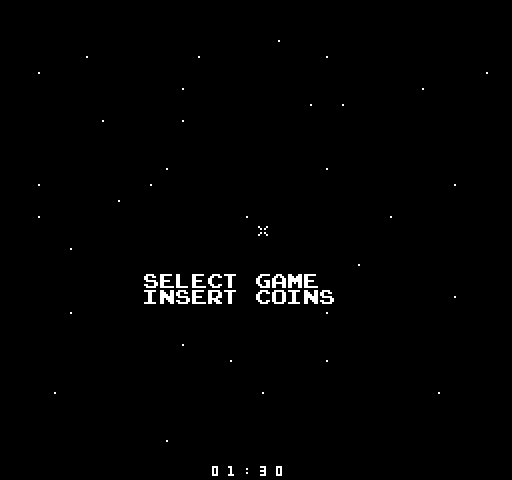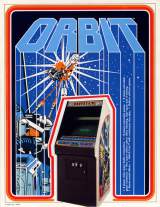
Orbit © 1978 Atari.
GAME LEVELS. The game level can be selected at the beginning of the game or after game select button has been pressed. Press the buttons from 1 to 10.
BEGINNER: Instant start/stop when pressing forward. Level Options :
1. Slow (Starship and Shells)
2. Medium (Starship and Shells)
3. Fast (Starship and Shells)
INTERMEDIATE: Accelerates to full speed when forward pushbutton pressed. Partial breaking when forward pushbutton released. Level Options :
4. Slow (Starship and Shells)
5. Fast (Starship and Shells)
EXPERT: Acceleration to full speed when forward pushbutton pressed. Level Options:
6. Fast shells (Shells only)
7. Slow (Starship and Shells)
8. Medium (Starship and Shells)
9. Fast (Starship and Shells)
SUPER EXPERT: Same as Expert, with a strong gravity option. Level Options :
10. Fast (Starship and Shells)
GAME OPTIONS: These toggles can be selected at any time during play by pressing the buttons from 1 to 8.
1. Bounce Back - Sets boundaries around perimeter of the TV monitor screen. Example: Starship immediately reverses direction after reaching boundary. Normally perimeter boundaries do not exist.
2. Negative Gravity - Sun radiates gravity outward to perimeter boundaries of the TV monitor screen. Normal sun state radiates positive gravity (positive gravity is inward toward the sun).
3. Zero Gravity - Sun does not radiate gravity.
4. Black Hole - Invisible sun with any selected gravity.
5. Space Stations - Two space stations orbit around sun. Each player is designated a specific space station on which he may land for repairs, fuel and shells. When player starship touches opponent's station it is immediate annihilation.
6. Unlimited Supplies - Unlimited fuel and ordnance (fire power).
7. Stars - Remove stars from playfield.
8. Strong Gravity - Unusually strong positive gravity.

Game ID: 033689-033702
Main CPU: M6800 (@ 756 Khz)
Sound Chips: Discrete circuitry.
The game has a total of 22 buttons:
The top row of 10 are used for selecting the game level and the game options.
2 center buttons are used for Game Select and Heat Reset.
Each player has 5 buttons to control his ship : Thrust, Fire, Rotate Right, Rotate Left, and Hyperspace
Orbit was released in November 1978, selling at an MSRP of $1295.
On Orbit, Owen was basically asked to knock off Steve Russell's 'Spacewar!' (the first vector video game ever written: 1962!) in RASTER for the European market in just 6 to 8 weeks, it was done quickly and there are small mistakes. Owen should have made the shots bigger for example, and the space stations could have had better graphics. But for a raster version of an original vector game in those days, Atari hit it fairly well.
There was 2 versions, a large upright cabinet (that may never have been shipped) and the smaller one with the long row of buttons. Atari did a very advanced version in the larger cabinet that had an electronic touch pad and lots of LEDs to indicate which options were selected, with a different type of buttons from the small cabinet. It was a very cool touch pad but all the same functions were there, just in a small space. It was a large cabinet with the touch pad over the monitor. The stereo sound was cool because it placed the sound where the objects were on the screen.
Owen also changed the option buttons to always work because he hated that in 'Spacewar!', once you picked the game and options, you were stuck with them for the entire game. If you bought and were playing a 15 minute game, it was a long time to realize you should not have picked negative gravity! Also, Owen needed to add something to the game to make it different (in addition to the switchable options), so the idea of getting new fuel, shots, and repairs from Space Stations seemed like a cool idea at the time. Too bad it did not work as well as Owen thought it would. That is why they are an option.
An interesting note on Orbit was that the space stations actually DO orbit the sun, they are not on tracks. Owen gave them an initial hit of velocity at the start of each wave and the gravity routines do the rest (they ignore negative gravity, because the first time you selected it, they would fly off the screen). To test the gravity routines, on the bench Owen put the space stations into orbit around the sun, and just let it run for days. Several days later, they were still in orbit, but degraded a bit and a bit more elliptical. They finally lost orbit a few days later. Not that Owen needed to do this, he could have put them on tracks, but he wanted his 8 bit gravity math to work as well as possible all the other time.
Present in the same graphics ROM as the object graphics, these initials (L.R., O.R., L.Y., M.H., and P.M.) are those of people who worked at Atari's early arcade days:
Lyle Rains
Owen Rubin
(unknown who L.Y. is)
Morgan Hoff
Paul Mancuso
According to Rubin, the initials would be displayed if a special sequence was entered on the game's number pad. Unfortunately, close examination of the game's code reveals that this sequence is no longer present. Given that Atari had a thing against crediting their game programmers/designers/etc., it's very possible they discovered the code and removed it rather than erase the initials, figuring that there would be absolutely no other way consumers would be able to see these.
Designed & programmed by: Owen Rubin
Game's ROM.
Game's picture.